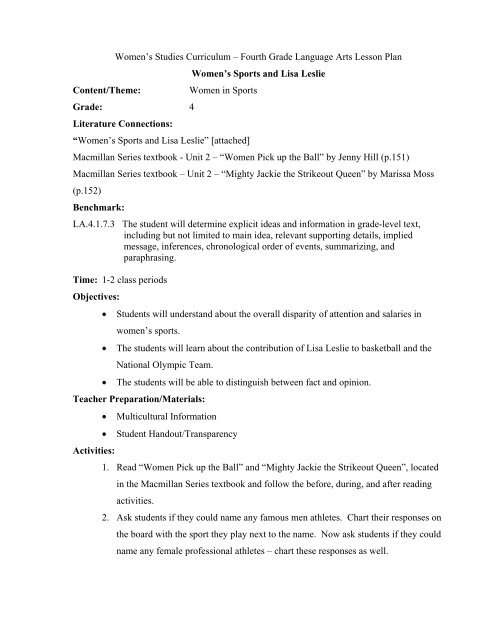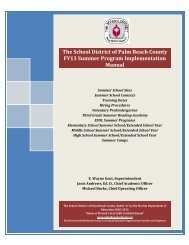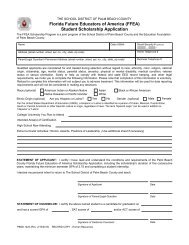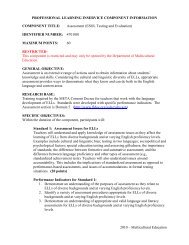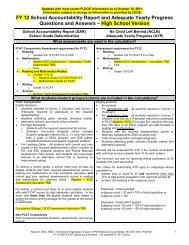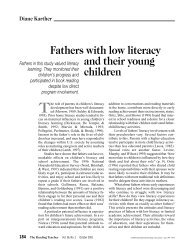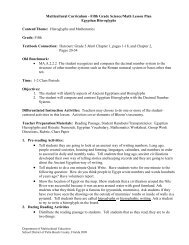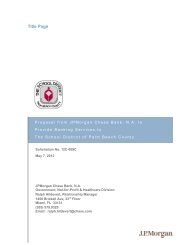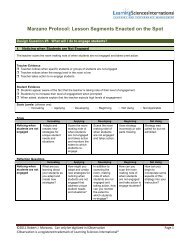Kindergarden Multicultural Curriculum Lesson Plan - The School ...
Kindergarden Multicultural Curriculum Lesson Plan - The School ...
Kindergarden Multicultural Curriculum Lesson Plan - The School ...
Create successful ePaper yourself
Turn your PDF publications into a flip-book with our unique Google optimized e-Paper software.
Women’s Studies <strong>Curriculum</strong> – Fourth Grade Language Arts <strong>Lesson</strong> <strong>Plan</strong><br />
Women’s Sports and Lisa Leslie<br />
Content/<strong>The</strong>me: Women in Sports<br />
Grade: 4<br />
Literature Connections:<br />
“Women’s Sports and Lisa Leslie” [attached]<br />
Macmillan Series textbook - Unit 2 – “Women Pick up the Ball” by Jenny Hill (p.151)<br />
Macmillan Series textbook – Unit 2 – “Mighty Jackie the Strikeout Queen” by Marissa Moss<br />
(p.152)<br />
Benchmark:<br />
LA.4.1.7.3 <strong>The</strong> student will determine explicit ideas and information in grade-level text,<br />
including but not limited to main idea, relevant supporting details, implied<br />
message, inferences, chronological order of events, summarizing, and<br />
paraphrasing.<br />
Time: 1-2 class periods<br />
Objectives:<br />
• Students will understand about the overall disparity of attention and salaries in<br />
women’s sports.<br />
• <strong>The</strong> students will learn about the contribution of Lisa Leslie to basketball and the<br />
National Olympic Team.<br />
• <strong>The</strong> students will be able to distinguish between fact and opinion.<br />
Teacher Preparation/Materials:<br />
• <strong>Multicultural</strong> Information<br />
• Student Handout/Transparency<br />
Activities:<br />
1. Read “Women Pick up the Ball” and “Mighty Jackie the Strikeout Queen”, located<br />
in the Macmillan Series textbook and follow the before, during, and after reading<br />
activities.<br />
2. Ask students if they could name any famous men athletes. Chart their responses on<br />
the board with the sport they play next to the name. Now ask students if they could<br />
name any female professional athletes – chart these responses as well.
3. Add Lisa Leslie to the chart of women athletes and tell students that today you will<br />
be learning about her. Ask students why they think they listed more male athletes<br />
than female. Get students to realize that male sports, in general, are given more<br />
media attention by asking if they see more men’s sports on TV or more women’s<br />
sports on TV. Ask students if they could guess about the salary of one of the male<br />
athletes listed and ask about the salary of Lisa Leslie, WNBA basketball star. Tell<br />
students their salaries are not the same. Ask students if they think their salaries<br />
should be the same if they have the same job.<br />
4. Tell students that there was a time where women’s professional sports did not exist.<br />
Very slowly, over the years, professional women’s teams have been created. <strong>The</strong>re<br />
are professional basketball and soccer teams, but not baseball. Tell students that<br />
they are going to read about some differences between men’s and women’s sports<br />
and find out about one famous woman basketball star, Lisa Leslie.<br />
5. Use “Women’s sports and Lisa Leslie” as a handout or transparency for guided<br />
reading purposes, or have students pair for reading and answer the questions<br />
together. Review information about Lisa Leslie with the students. Have students<br />
conduct fact and opinion activity in pairs. (Teacher may want to review fact and<br />
opinion with students before activity.) Answers to quiz: 1. b 2. c 3. c 4.<br />
Answers vary<br />
6. Tell students to look in the newspaper (sports section) for articles about the WNBA<br />
or about any female athletes. Have students share their article with the class.<br />
7. Take students on a virtual tour of the biography of Lisa Leslie (use the internet with<br />
the projector or media cart) by going to:<br />
http://www.wnba.com/playerfile/lisa_leslie/bio.html and<br />
ESOL Strategies: Read Aloud, Guided Reading, and Visuals<br />
Review of <strong>Lesson</strong> and Assessment:<br />
• Student participation, student work<br />
Resources:<br />
http://www.wnba.com/playerfile/lisa_leslie/bio.html
<strong>Multicultural</strong> Information:<br />
It used to be people thought sports for girls was “un-lady-like.” People also thought<br />
that girls weren’t strong enough to compete. But as women began to voice their opinions,<br />
attitudes began to change. <strong>The</strong>n in 1972, the United States created a statute, a law, called Title<br />
IX, making schools offer equal opportunity for girls in sports. It has taken many years, but now<br />
professional women’s teams in basketball and soccer have been created.<br />
Over the years, women have progressed in sports. Today, you can find women in every<br />
sport, including basketball, soccer and even football. Unfortunately, professional female<br />
athletes have not yet received the same dues as male athletes. <strong>The</strong> lack of media coverage<br />
(television and newspapers) can be to blame. In sports sections of newspapers, females do not<br />
get nearly as many headlines as males, unless it is a big event such as the U.S. Open. More<br />
deeply, this discrimination runs in salaries. In addition, male athletics get paid more than<br />
females. This may be due to the lower ratings female leagues get. It could be that male leagues<br />
get more ratings and larger audiences so they get paid a lot more. At the same time, it’s much<br />
easier to find NBA and NFL games on network television and harder to find professional<br />
female sports. WNBA salaries range from $25, 000 to $65, 000, which is only a small fraction<br />
of the million dollar salaries of many NBA players.<br />
Lisa Leslie is one of these female WNBA athletes. She has been in the league since<br />
1997. Lisa began her professional career playing for the Los Angles Sparks, and is still with<br />
them as of the 2004 season. Before playing professionally, she played for her college and high<br />
school. She has also been chosen to play for the United States Women’s National Team for the<br />
Olympics in 1996 and 2000, where the teams won the gold medal each time. She has various<br />
awards and highlights in her career such as, all-time leading scorer in 2002, and the first<br />
WNBA player to slam-dunk in a game during a game against the Miami Sol in July of 2002.<br />
Personally, Lisa has tried to put herself in the media as much as possible by modeling, and<br />
staring in popular sitcoms like Moesha and Who Wants to Be a Millionaire? When asked who<br />
is her role model, Lisa says her mother. Lisa has proven that women can be strong and<br />
successful in a male dominated sport, and she hopes more women will participate and be
treated equally in sports in the future. When she is finished playing basketball, she hopes to<br />
continue in the sport by broadcasting.<br />
NAME________________________________________________________________<br />
Women’s Sports and Lisa Leslie
People used to think that women could not play sports as well as men. It was<br />
very hard for women to train to be an athlete in high school and college. People were<br />
too interested in the men’s teams. Back then, it was very hard for women’s<br />
professional teams to get started. But, women began to speak up. <strong>The</strong>y wanted to be<br />
equal in sports. In 1972, the United States created a statute, a law, called Title IX,<br />
making schools offer equal chances for girls in sports. It has taken many years, but<br />
now professional women’s teams in sports have been created.<br />
Today, you can find women in every sport, including basketball, soccer, and<br />
even football. But many professional female athletes have not received equal<br />
treatment like professional male athletes. Most male athletes get paid more than<br />
female athletes in the same sport. This may be because more people watch male<br />
sports than female sports. But, female athletes hope this changes in the future. For<br />
example, in the Women’s National Basketball Association (WNBA) most of the<br />
women make about $25, 000 to $75, 000, and in the men’s NBA, some of the men<br />
can make millions of dollars.<br />
Lisa Leslie is a WNBA athlete. She has been in the league since it was<br />
created in 1997. Lisa began her professional career playing for the Los Angles<br />
Sparks. She has been loyal to the Sparks as of the 2004 season. Before playing<br />
professionally, she played for her college and high school. She has also been chosen<br />
to play for the United States Women’s National Team for the Olympics in 1996 and<br />
2000. Both times these teams won the gold medal for the United States. Lisa has<br />
various awards and highlights in her career such as: all-time leading scorer in 2002,<br />
and the first WNBA player to slam-dunk in a game during a game against the Miami<br />
Sol in July of 2002. Lisa is one of the best players in the league.<br />
Personally, Lisa loves to be in the media. She is also a great model. Lisa has<br />
even starred in popular sitcoms like Moesha and Who Wants to Be a Millionaire?<br />
When asked who is her role model, Lisa says her mother. Lisa believes that women<br />
can be strong and successful, just like men, in sports. She hopes more girls and<br />
women will participate and be treated equally in sports in the future. When she is<br />
finished playing basketball, she hopes to continue in the sport by broadcasting.<br />
NAME________________________________________________________________
QUIZ<br />
WOMEN’S SPORTS AND LISA LESLIE<br />
Directions: After reading the passage, circle the best answer to the following questions:<br />
1. Which of the following changed the way schools treated girls in sports:<br />
a. more newspapers reported girls sports b. a law, Title IX was created<br />
c. girls sports were on the television d. girls stopped playing sports<br />
2. Which of the following is evidence that women are not treated the same as men in<br />
professional sports:<br />
a. Women are not allowed to play in professional sports.<br />
b. Women are not given contracts for commercials.<br />
c. Women are not paid the same as men in professional sports.<br />
d. Women’s teams do not have nice uniforms like the men’s teams.<br />
3. When was the WNBA created?<br />
a. 2002 b. 1996<br />
c. 1997 d. 1970<br />
4. List three FACTS and three OPINIONS that you found about Lisa Leslie in the passage:<br />
FACTS<br />
OPINIONS


